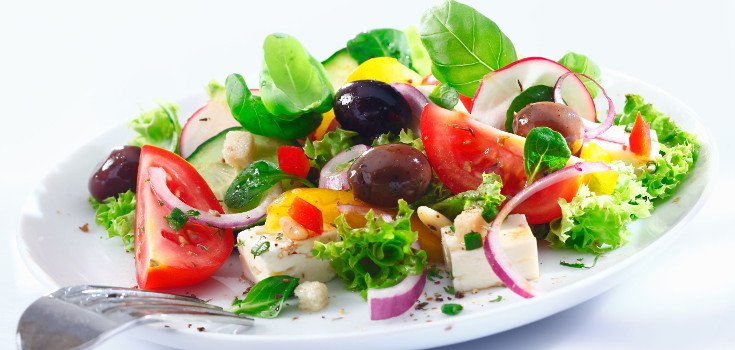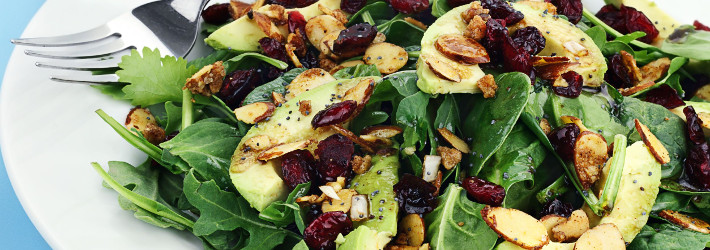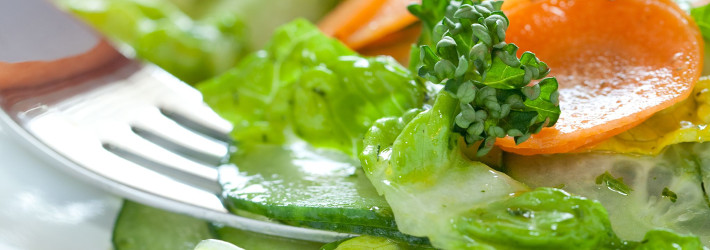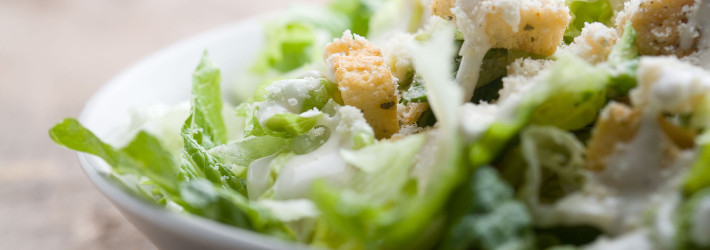4 Tips for Making the Ultimate Healthy Salad
4 Tips for Making the Ultimate Healthy Salad
Whether they’re made at home or bought from a salad bar, raw vegetable salads are a big favorite of health-conscious people looking for maximum nutrition.
Whether they’re made at home or bought from a salad bar, raw vegetable salads are a big favorite of health-conscious people looking for maximum nutrition. But all raw salads are not created equal. What you choose to include can make the difference between a nutritional powerhouse and a salad that’s just ordinary. Here are 4 tips for making the ultimate healthy salad.
1. Start With the Right Green Foundation
Iceberg lettuce is the traditional favorite, but of all the greens, iceberg isin nutritional value. Spinach tops the list for nutrition, providing optimal levels of vitamin K and magnesium, the mineral that plays a role in almost every function in the body.
Vitamin A, zinc, phosphorus, and copper in spinach make eating it a great defense against osteoporosis. Recenthas shown that glycoglycerolipids from spinach can help protect the lining of the digestive tract from damage, including the damaging effects of inflammation.
In an evaluation of the relationship between risk of prostate cancer and intake of several different vegetables, spinach was the one vegetable to show evidence of significant protection against occurrence of aggressive prostate cancer.
Spinach and kale also contain two powerful carotenoids, lutein and zeaxanthin. These two carotenoids have shown great benefitsfor eye health, warding off macular degeneration and reducing risk of cataracts. If a whole foundation of spinach is too much, combine it with kale, romaine, or field greens.
Each is an excellent source of folate, the vitamin that keeps skin and hair looking healthy and young, and chromium, the mineral that normalizes blood pressure and. And there is plenty of potassium, the mineral that works with sodium to normalize heart beats.
2. Load up the Colors
The produce counter is a colorful place, and each color represents vegetables with unique actions in the body. The more colors that can be piled on the salad’s green foundation, the more nutritional benefits will be derived when the salad is eaten. Specific color groups can also be added to target problems in the body.
Carrots and yellow and orange bell peppers are known for their abundance of beta carotene, a free radical scavenger that maintains cellular integrity. Free radicals are thought to be the force behind many aspects of aging, such as cardiovascular disease, inflammation,and arthritis. And there is vitamin C in yellow and orange vegetables that promotes skin free if wrinkles because it is the vitamin that powers the collagen matrix.
Red vegetables such as tomatoes, red bell peppers, and hot chili peppers are great sources of lycopene, the carotenoid that can fightsingle handedly. Two special acids found in tomatoes block damage done byproduced during cigarette smoking. There has been much written about the dangers of eating meats preserved with sodium nitrate, but adding tomatoes has been shown to alleviate that effect.
Another red vegetable that’s a must-have is beets. Even though they are usually cooked, it’s worth sneaking them into a raw vegetable salad, because theythe liver and bile ducts.
Beets are a good source of a betaines, one of which protects the body from osmotic stress that can lead to dehydration. A betaine known asor TMG is an important cofactor in the methylation process that occurs in all mammalian cells for the purpose of creating neurotransmitters such as dopamine and serotonin. Methylation is also needed for making melatonin and coenzyme Q10, the substance so needed by anyone taking statin drugs.
Don’t overlook white vegetables. Onions and garlic are known as superfoods because they are high in sulfur, another mineral deficient in many people. This duo is known for normalizing blood sugar, keeping down inflammation, and normalizing cholesterol levels, as well as for its antibiotic properties. There is eventhey can stop tumor growth.
Add some cauliflower, one of the cruciferous vegetables that have been found to lower the risk of several cancers including breast cancer. And don’t forget mushrooms, documented to be a powerful. Then toss in a couple of pieces of some of the more exotic fare such as jicama.
Crown your salad with purple vegetables, the group having the most deep, vibrant coloration in the entire plant kingdom. This color comes from anthocyanins, special pigments with antioxidant action that are now being investigated for their other benefits. This group includes purple cabbage (another cruciferous vegetable) that also has the ability toof enzymes used in detoxification processes. And if any purple corn is around, be sure to grab some. Purple corn tops blueberries for high anthocyanin content, and has been found toby reducing cancer cell viability and increasing apoptosis (cell death). It also has chemotherapeutic action against cancer involving mutations in certain genes.
3. Dress for Success
Finish off that beautiful salad with the right dressing. This means steering clear of most bottled dressings, even if you are shopping in a health oriented grocery store. These dressings are made with polyunsaturated oils, which consist of long chain fatty acids, the ones that can help youbecause they are stored as fat rather than used as energy. But don’t choose low fat dressing instead. That is almost always loaded with sugar as a substitute for fat.
Look for a dressing made with extra virgin olive oil, the oil that is part of the Mediterranean diet, shown in research tofrom all causes. Olive oil contains mostly medium chain fatty acids, the kind that are used for energy rather than storage. If you can’t find a bottled version, make it at home with one of the many recipes found online.
4. Skip the Milk Protein
Those carotenoids mentioned earlier are some of the healthiest parts of the salad, so don’t undermine them by adding anything containing milk protein, including cheese and buttermilk dressing.that milk protein binds with carotenoids and makes them unavailable for use in humans.
Other Popular Stories:
There are no related stories quite yet.





Post a Comment